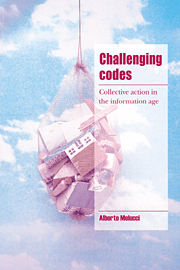Book contents
- Frontmatter
- Contents
- Preface and acknowledgements
- Introduction
- Part I Theory of collective action
- Part II Contemporary collective action
- Part III The field of collective action
- Part IV Acting collectively
- 15 Mobilization and political participation
- 16 The organization of movements
- 17 Leadership in social movements
- 18 Collective action and discourse
- 19 Forms of action
- 20 Research on collective action
- References
- Index
19 - Forms of action
Published online by Cambridge University Press: 23 November 2009
- Frontmatter
- Contents
- Preface and acknowledgements
- Introduction
- Part I Theory of collective action
- Part II Contemporary collective action
- Part III The field of collective action
- Part IV Acting collectively
- 15 Mobilization and political participation
- 16 The organization of movements
- 17 Leadership in social movements
- 18 Collective action and discourse
- 19 Forms of action
- 20 Research on collective action
- References
- Index
Summary
Revolutions
In this chapter I shall focus on several forms of collective action which are frequently associated with the study of social movements. The discussion of these forms should demonstrate the utility of an analytical approach to collective action which is able to differentiate levels and meanings, particularly when complex historical phenomena are considered.
Let us start with revolutions. After many classic studies (Johnson 1964; Brinton 1965; Hobsbawm 1962), writing and discussion on revolution still continues steadily. No other topic is so resistant to analysis as revolution. Apart from the affective investments and political implications that characterize it, the difficulty stems from the fact that revolution is always a global phenomenon whose analytical meanings are extremely difficult to unravel.
Evidence of this situation is provided by the wide variety of the definitions given to the term, and the equally wide variety of misunderstandings that continue to surround it (for a general introduction, see Aya 1990; De Fronzo 1991). Only twenty years ago, one of the most systematic bibliographies on the topic, published in 1976 (Blackey 1976), comprised about 2,400 titles, and since then the list has considerably increased in length (see the most recent studies by Tilly 1993 and Skockpol 1994). Nevertheless, as before the confusion of languages reigns supreme. The object of identification or rejection, a goal pursued or an event expected, a phenomenon to be observed and analysed, revolution still retains the glamour of a controversial myth and still prompts people to take sides.
- Type
- Chapter
- Information
- Challenging CodesCollective Action in the Information Age, pp. 361 - 379Publisher: Cambridge University PressPrint publication year: 1996

